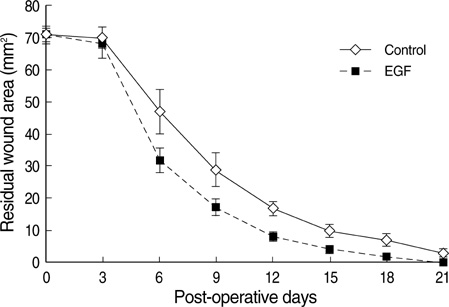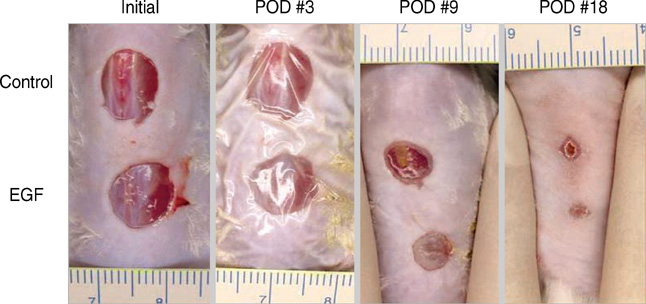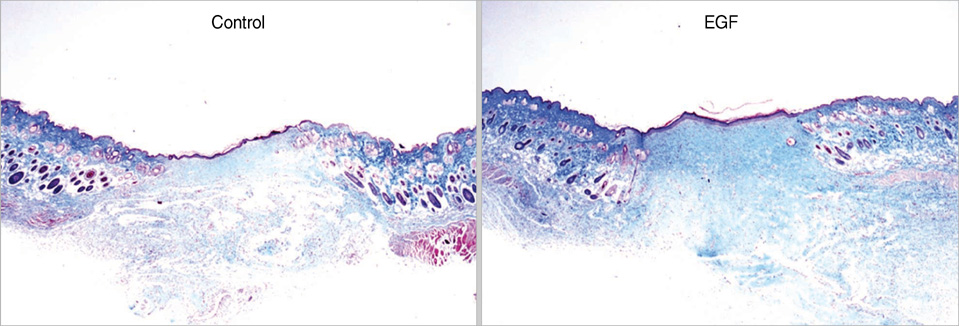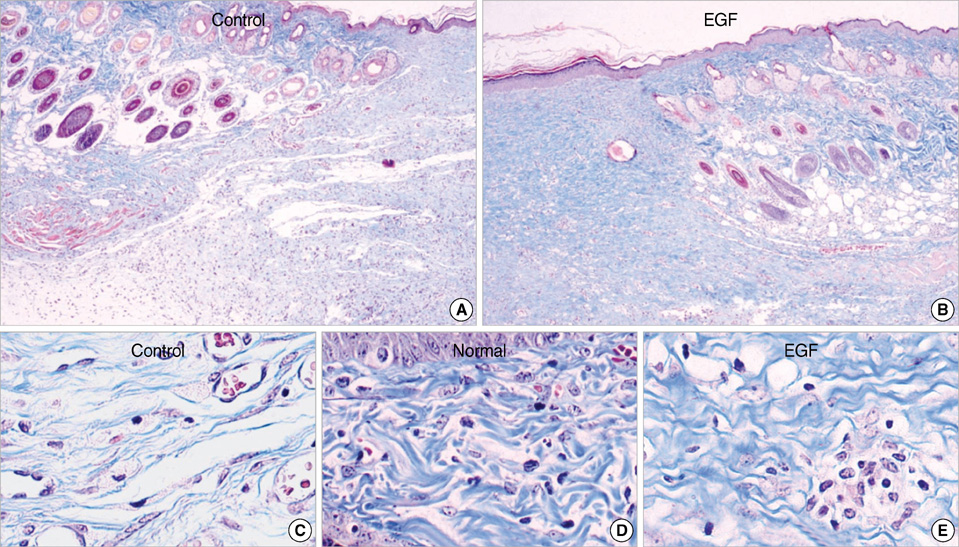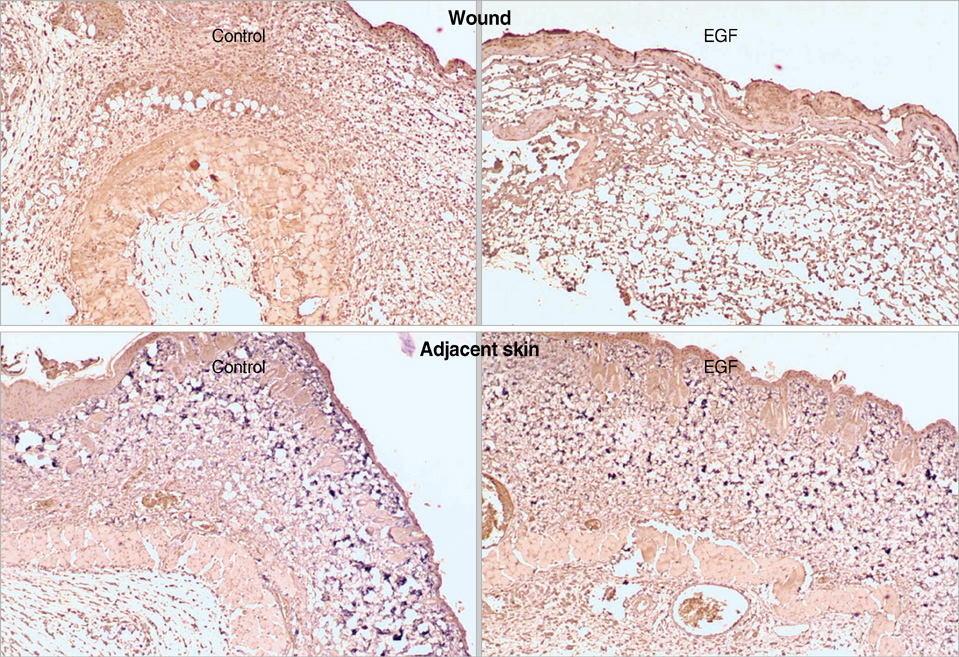J Korean Med Sci.
2010 Apr;25(4):589-596. 10.3346/jkms.2010.25.4.589.
Effect of Recombinant Human Epidermal Growth Factor Against Cutaneous Scar Formation in Murine Full-thickness Wound Healing
- Affiliations
-
- 1Institute for Human Tissue Restoration, Department of Plastic & Reconstructive Surgery, Yonsei Medical Center, Yonsei University College of Medicine, Seoul, Korea. dhlew@yuhs.ac
- 2Department of Plastic & Reconstructive Surgery, Asan Medical Center, Ulsan University, College of Medicine, Seoul, Korea.
- KMID: 1792930
- DOI: http://doi.org/10.3346/jkms.2010.25.4.589
Abstract
- A visible cutaneous scar develops from the excess formation of immature collagen in response to an inflammatory reaction. This study examined the role of epidermal growth factor (EGF) in the formation of cutaneous scars. Twenty Crl:CD-1 (ICR) mice were used and 2 full-thickness skin wounds were made on the dorsum of each mouse. One of the wounds was treated with recombinant human EGF by local application and the other was treated with saline for control until complete healing was achieved. The EGF-treated group's wounds healed faster than the control group's. The width of the scar was smaller by 30% and the area was smaller by 26% in the EGF-treated group. Inflammatory cell numbers were significantly lower in the EGF-treated group. The expression of transforming growth factor (TGF)-beta1 in the EGF-treated group was increased. It was observed that the amount of collagen in the EGF-treated group was larger than the control group. In the EGF-treated group, the visible external scars were less noticeable than that in the control group. These results suggest that EGF can reduce cutaneous scars by suppressing inflammatory reactions, decreasing expression of TGF-beta1, and mediating the formation of collagen.
Keyword
MeSH Terms
Figure
Cited by 1 articles
-
The Effects of Multi-Growth Factors-Containing Cream on Post-Thyroidectomy Scars: A Preliminary Study
Sungsik Shin, Jung U Shin, Youngin Lee, Woong Youn Chung, Kee-Hyun Nam, Tae Gwang Kwon, Ju Hee Lee
Ann Dermatol. 2017;29(3):314-320. doi: 10.5021/ad.2017.29.3.314.
Reference
-
1. Lorenz HP, Longaker MT. Mathes SJ, editor. Wound healing: Repair biology and wound and scar treatment. Plastic surgery. 2006. vol 1:2nd ed. Philadelphia: Saunders;209–235.2. Dang CM, Beanes SR, Soo C, Ting K, Benhaim P, Hedrick MH, Lorenz HP. Decreased expression of fibroblast and keratinocyte growth factor isoforms and receptors during scarless repair. Plast Reconstr Surg. 2003. 111:1969–1979.
Article3. Cass DL, Bullard KM, Sylvester KG, Yang EY, Longaker MT, Adzick NS. Wound size and gestational age modulate scar formation in fetal wound repair. J Pediatr Surg. 1997. 32:411–415.
Article4. Longaker MT, Whitby DJ, Adzick NS, Crombleholme TM, Langer JC, Duncan BW, Bradley SM, Stern R, Ferguson MW, Harrison MR. Studies in fetal wound healing: VI. Second and early third trimester fetal wounds demonstrate rapid collagen deposition without scar formation. J Pediatr Surg. 1990. 25:63–68.
Article5. Lorenz HP, Whitby DJ, Longaker MT, Adzick NS. Fetal wound healing: The ontogeny of scar formation in the non-human primate. Ann Surg. 1993. 217:391–396.
Article6. Lorenz HP, Longaker MT, Perkocha LA, Jennings RW, Harrison MR, Adzick NS. Scarless wound repair: a human fetal skin model. Development. 1992. 114:253–259.
Article7. Shah M, Foreman DM, Ferguson MW. Neutrolizing antibody to TGF-beta 1,2 reduces cutaneous scarring in adult rodents. J Cell Sci. 1994. 107:1137–1157.8. Hynes JH, Johnson DE, Mast BA, Diegelmann RF, Salzberg DA, Cohen IK, Krummel TM. Platelet-derived growth factor induces fetal wound fibrosis. J Pediatr Surg. 1994. 29:1405–1408.9. Brown GL, Nanney LB, Griffen J, Cramer AB, Yancey JM, Curtsinger LJ 3rd, Holtzin L, Schultz GS, Jurkiewicz MJ, Lynch JB. Enhancement of wound healing by topical treatment with epidermal growth factor. N Engl J Med. 1989. 321:76–79.
Article10. Peled ZM, Rhee SJ, Hsu M, Chang J, Krummel TM, Longaker MT. The ontogeny of scarless healing II: EGF and PDGF-B gene expression in fetal rat skin and fibroblast as a function of gestational age. Ann Plast Surg. 2001. 47:417–424.11. Satici A, Guzey M, Dogan Z, Kilic A. Relationship between tear TNF-alpha, TGF-beta1, and EGF levels and severity of cunjunctival cicatrization in patients with inactive trachoma. Ophthalmic Res. 2003. 35:301–305.12. Repertinger SK, Campagnaro E, Fuhrman J, El-Abaseri T, Yuspa SH, Hansen LA. EGFR enhances early healing after cutaneous incisional wounding. J Invest Dermatol. 2004. 123:982–989.
Article13. Wilgus TA, Vodovotz Y, Vittadini E, Clubbs EA, Oberyszyn TM. Reduction of scar formation in full-thickness wounds with topical celecoxib treatment. Wound Repair Regen. 2003. 11:25–34.
Article14. Liu W, Chua C, Wu X, Wand D, Ying D, Cui L, Cao Y. Inhibiting scar formation in rat wounds by adenovirus-mediated overexpression of truncated TGF-beta receptor II. Plast Reconstr Surg. 2005. 115:860–870.15. Cohen S. Isolation of a mouse submaxillary gland protein accelerating incisor eruption and eyelid opening in the new-born animal. J Biol Chem. 1962. 237:1555–1562.
Article16. Fisher DA, Lakshmanan J. Metabolism and effects of epidermal growth factor and related growth factors in mammals. Endocr Rev. 1990. 11:418–442.
Article17. Bennett NT, Schultz GS. Growth factors and wound healing: biochemical properties of growth factors and their receptors. Am J Surg. 1993. 165:728–737.
Article18. Mimura Y, Ihn H, Jinnin M, Asano Y, Yamane K, Tamaki K. Epidermal growth factor induces fibronectin expression in human dermal fibroblasts via protein kinase C δ signaling pathway. J Invest Dermatol. 2004. 122:1390–1398.
Article19. Brown GL, Curtsinger L 3rd, Brightwell JR, Ackerman DM, Tobin GR, Polk HC Jr, George-Nascimento C, Valenzuela P, Schultz GS. Enhancement of epidermal regeneration by biosynthetic epidermal growth factor. J Exp Med. 1986. 163:1319–1324.
Article20. Brown GL, Curtsinger L, Jurkiewicz MJ, Nahai F, Schultz G. Stimulation of healing of chronic wounds by epidermal growth factor. Plast Reconstr Surg. 1991. 88:189–194.
Article21. Liu M, Warn JD, Fan Q, Smith PG. Relationships between nerves and myofibroblasts during cutaneous wound healing in the developing rat. Cell Tissue Res. 1999. 297:423–433.
Article22. Baek RM, Song YT, Baek SJ, Lee JH, Im TG, Yoon BH. Effects of the recombinant human epidermal growth factor on full thickness wound of the rat skin. J Korean Soc Plast Reconstr Surg. 2003. 30:201–208.23. Babül A, Gonul B, Dincer S, Erdogan D, Ozogul C. The effect of EGF application in gel form on histamine content of experimentally induced wound in mice. Amino Acids. 2004. 27:321–326.
Article
- Full Text Links
- Actions
-
Cited
- CITED
-
- Close
- Share
- Similar articles
-
- The Effect of Epidermal Growth Factor in Wound Healing
- The Accelerated Epithelization of Recombinant Epidermal Growth Factor on Partial-thickness Skin Wounds
- An Experimental Study on the Wound Healing Effects of Recombinant Human Epidermal Growth Factors According to Poloxamer Concentrations in Full-thickness Excisional Wound Models of Rats
- Effects of the Recombinant Human Epidermal Growth Factor on Full-thickness Wound of the Rat Skin
- The effect of epidermal growth factor in wound healing of skin defect

